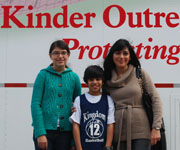Research may save lives of young athletes
March 19, 2011 - The Houston Chronicle "Viewpoints" section published this article by Dr. James T. Willerson, Dr. Paolo Angelini, and Meredith J. Long concerning the activities of the Texas Heart Institute Center for Coronary Artery Anomalies, including the Houston MRI Screening Study.
An East Texas high school's star athlete throws a game-winning touchdown pass, comes to the sidelines and, seconds later his heart stops — without warning, without medical history of previous problems. His death is shockingly sudden.
A western Michigan high school star scores the winning overtime basket to cap his team's perfect winning season and collapses on the court, never to recover.
Just two days later, a 17 year-old Colorado athlete dies of sudden cardiac arrest during a rugby match.
These incidents happen too often. When they do, they capture national headlines for a day or two, then recede from our collective consciousness, leaving us all shaking our heads and wringing our hands over the senseless tragedy of it all.
In most of these cases, we know the cause. More often than not, these sudden deaths in young athletes - both male and female - are tied to certain heart abnormalities that some children are born with and that are relatively difficult to detect. An abnormal thickening of the heart known as hypertrophic cardiomyopathy can cause fatal abnormal rhythms in the heart, interrupting abruptly its function. Another condition involves an abnormality in the major artery supply to the heart (coronary arteries), which can also lead to abnormal and life-threatening heart rhythms. A third important cause of sudden cardiac death is the deposition of fat and fibrous tissue in the right heart.
These conditions often manifest themselves when unknowing and otherwise fit young people are under exertion, such as during a sports competition or in basic training for the military.
These anomalies are about 70 percent of the recognized causes of sudden cardiac death in the U.S., and in too many cases, the first symptoms are the last. Thus the poignant - and fleeting - headlines.
A public policy debate has raged for years about whether more intense heart health screenings, including electrocardiograms, should be required before young athletes play sports. Are the costs too high for such screenings? Is the prevalence of these heart anomalies too low to justify the costs? And even electrocardiograms have been shown to be effective in detecting such abnormalities only 50 percent to 70 percent of the time.
So, what can we do?
Fortunately, there is much more to do than simply wring our hands in endless debate. And fortunately, Houston is home to foresighted people like Rich and Nancy Kinder and their Kinder Foundation, who have helped to underwrite ongoing research into these problems. This research, through the Center for Coronary Artery Anomalies at the Texas Heart Institute at St. Luke's Episcopal Hospital, includes the screening of 10,000 middle school students in the Houston Independent School District and other area schools to detect abnormalities in the heart prior to their leading to sudden death in children.
Using the most accurate detection methods - a combination of electrocardiography (EKG) and Magnetic Resonance Imaging (MRI) - our mobile imaging unit has been in the field for several months now and has screened almost 500 young athletes and other students. The screening basically involves taking pictures of these students' hearts. No needles or drugs are involved.
This prevention-oriented research hopefully will help us answer the important health and public policy questions, and we will learn much more about both prevention and prevalence of the heart abnormalities in a large diverse population, such as Houston's.
Along the way, if students are found to suffer from these heart abnormalities, their parents and doctors will be able to make informed decisions about their children's health and sports participation.
It will be some time before the research is complete, but for now, there are two things we know for certain.
One is that these tragedies will continue to happen and will continue to make horrific headlines.
We also know that sitting on the sidelines and doing nothing while tragedy continues to strike is not an option.
Willerson is president and medical director of the Texas Heart Institute at St. Luke's Episcopal Hospital in Houston; Long is chairman of the THI Board of Directors.
Angelini is director of the THI Center for Coronary Artery Anomalies.
Download a PDF version of this article as it appeared in the Houston Chronicle.
For media inquiries please contact:
Texas Heart Institute at St. Luke's Episcopal Hospital
Frank Michel ♦ 832-355-9510 ♦ Email: fmichel@heart.thi.tmc.edu
For THI and St. Luke's media profiles, see Public Affairs.



